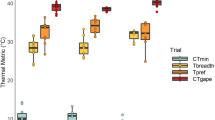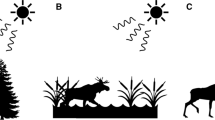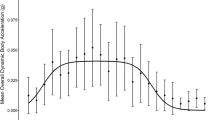Abstract
Context
Thermal traits likely mediate organismal responses to changing thermal environments. As temperatures increase, predicting species responses will depend on understanding how thermal traits vary within and among individuals and across time and space.
Objectives
We evaluated variation in thermal traits within and among individual Mojave Desert Tortoises, using GPS telemetry to quantify movement performance and animal-mounted sensors to measure carapace temperatures.
Methods
We constructed thermal performance curves (TPCs) based on movement velocity and assessed variation in associated thermal traits by sex, season, and proximity to roads. We also examined the temperature-dependence of monthly home ranges and the frequency of high-displacement movements.
Results
Individuals exhibited lower variation in upper critical temperatures (CTmaxE) than in other traits, such as optimum temperatures and lower critical temperatures for movement. All thermal traits varied within individuals, either by season or proximity to roads. We also found that monthly home range size and the frequency of high-displacement movements increased with the time individuals spent within their optimal temperature range; however, this effect was only apparent during months with greater rainfall.
Conclusions
Low standing variation in CTmaxE suggests that this trait may be constrained, limiting potential changes through acclimation or selection in warming environments. Our results demonstrate the modifying effect of rainfall on temperature-space use relationships and highlight the dependence of thermal traits on ecological and landscape contexts. Field-based TPCs derived from GPS movement tracks provided ecologically-relevant estimates of thermal traits and suggest an informative framework for unifying elements of thermal biology and spatial ecology.




Similar content being viewed by others
References
Agha M, Augustine B, Lovich JE, Delaney D, Sinervo B, Murphy MO, Ennen JR, Briggs JR, Cooper R, Price SJ (2015) Using motion-sensor camera technology to infer seasonal activity and thermal niche of the desert tortoise (Gopherus agassizii). J Therm Biol 49:119–126
Angilletta MJ Jr (2006) Estimating and comparing thermal performance curves. J Therm Biol 31:541–545
Angilletta MJ Jr, Angilletta MJ (2009) Thermal adaptation: a theoretical and empirical synthesis. Oxford University Press, Oxford
Angilletta MJ Jr, Wilson RS, Niehaus AC, Sears MW, Navas CA, Ribeiro PL (2007) Urban physiology: city ants possess high heat tolerance. PLoS ONE 2:e258
Araújo MB, Ferri-Yanez F, Bozinovic F, Marquet PA, Valladares F, Chown SL (2013) Heat freezes niche evolution. Ecol Lett 16:1206–1219
Bonebrake TC, Brown CJ, Bell JD, Blanchard JL, Chauvenet A, Champion C, Chen IC, Clark TD, Colwell RK, Danielsen F, Dell AI, Donelson JM, Evengard B, Ferrier S, Frusher S, Garcia RA, Griffis RB, Hobday AJ, Jarzyna MA, Lee E, Lenoir J, Linnetved H, Martin VY, McCormack PC, McDonald J, McDonald-Madden E, Mitchell N, Mustonen T, Pandolfi JM, Pettorelli N, Possingham H, Pulsifer P, Reynolds M, Scheffers BR, Sorte CJB, Strugnell JM, Tuanmu MN, Twiname S, Verges A, Villanueva C, Wapstra E, Wernberg T, Pecl GT (2017) Managing consequences of climate-driven species redistribution requires integration of ecology, conservation and social science. Biol Rev 93:284–305
Börger L, Fryxell JM (2012) Quantifying individual differences in dispersal using net squared displacement. In: Clobert J, Baguette M, Benton TG, Bullock JM (eds) Dispersal ecology and evolution. Oxford University Press, Oxford, pp 222–230
Calenge C (2019) Home range estimation in R: the adehabitatHR package, ver. 0.4.16
Childress ES, Letcher BH (2017) Estimating thermal performance curves from repeated field observations. Ecology 98:1377–1387
Clusella-Trullas S, Chown SL (2014) Lizard thermal trait variation at multiple scales: a review. J Comp Physiol B 184:5–21
Crowley SR (1985) Thermal sensitivity of sprint-running in the lizard Sceloporus undulatus: support for a conservative view of thermal physiology. Oecologia 66:219–225
Cushman SA, Huettmann F (2010) Spatial complexity, informatics, and wildlife conservation. Springer, New York
Deutsch CA, Tewksbury JJ, Huey RB, Sheldon KS, Ghalambor CK, Haak DC, Martin PR (2008) Impacts of climate warming on terrestrial ectotherms across latitude. Proc Natl Acad Sci USA 105:6668–6672
Dillon ME, Wang G, Huey RB (2010) Global metabolic impacts of recent climate warming. Nature 467:704–706
Duda JJ, Krzysik AJ, Freilich JE (1999) Effects of drought on desert tortoise movement and activity. J Wildl Manag 63:1181–1192
Edelhoff H, Signer J, Balkenhol N (2016) Path segmentation for beginners: an overview of current methods for detecting changes in animal movement patterns. Mov Ecol 4:21
Federal Register (1990) Endangered and threatened wildlife and plants determination fo threatened status for the mojave population fo the desert tortoise. Federal Register, 55:12178–12191
Frishkoff LO, Gabot E, Sandler G, Marte C, Mahler DL (2019) Elevation shapes the reassembly of Anthropocene lizard communities. Nat Ecol Evol 3:638
Frishkoff LO, Hadly EA, Daily GC (2015) Thermal niche predicts tolerance to habitat conversion in tropical amphibians and reptiles. Glob Change Biol 21:3901–3916
Gilbert AL, Lattanzio MS (2016) Ontogenetic variation in the thermal biology of yarrow's spiny lizard, Sceloporus jarrovii. PLoS ONE 11:e0146904
Greenspan SE, Bower DS, Roznik EA, Pike DA, Marantelli G, Alford RA, Schwarzkopf L, Scheffers BR (2017) Infection increases vulnerability to climate change via effects on host thermal tolerance. Sci Rep 7:9349
Grigg JW, Buckley LB (2013) Conservatism of lizard thermal tolerances and body temperatures across evolutionary history and geography. Biol Lett 9:20121056
Gvoždík L (2018) Just what is the thermal niche? Oikos 127:1701–1710
Hamblin AL, Youngsteadt E, López-Uribe MM, Frank SD (2017) Physiological thermal limits predict differential responses of bees to urban heat-island effects. Biol Let 13:20170125
Hertz PE, Huey RB, Stevenson RD (1993) Evaluating temperature regulation by field-active ectotherms: the fallacy of the inappropriate question. Am Nat 142:796–818
Hoffmann AA, Chown SL, Clusella-Trullas S, Fox C (2013) Upper thermal limits in terrestrial ectotherms: how constrained are they? Funct Ecol 27:934–949
Huey RB, Berrigan D (2001) Temperature, demography, and ectotherm fitness. Am Nat 158:204–210
Huey RB, Kearney MR, Krockenberger A, Holtum JA, Jess M, Williams SE (2012) Predicting organismal vulnerability to climate warming: roles of behaviour, physiology and adaptation. Phil Trans R Soc Lond B 367:1665–1679
Huey RB, Stevenson R (1979) Integrating thermal physiology and ecology of ectotherms: a discussion of approaches. Am Zool 19:357–366
Hutchison VH, Vinegar A, Kosh RJ (1966) Critical thermal maxima in turtles. Herpetologica 22:32–41
Kearney M, Porter WP (2004) Mapping the fundamental niche: physiology, climate, and the distribution of a nocturnal lizard. Ecology 85:3119–3131
Kearney M, Shine R, Porter WP (2009) The potential for behavioral thermoregulation to buffer “cold-blooded” animals against climate warming. Proc Natl Acad Sci USA 106:3835–3840
Llewelyn J, Macdonald SL, Hatcher A, Moritz C, Phillips BL, Franklin J (2016) Intraspecific variation in climate-relevant traits in a tropical rainforest lizard. Divers Distrib 22:1000–1012
MacMillan HA (2019) Dissecting cause from consequence: a systematic approach to thermal limits. J Exp Biol 222:jeb191593
Miles DB (2004) The race goes to the swift: fitness consequences of variation in sprint performance in juvenile lizards. Evol Ecol Res 6:63–75
Muñoz M, Bodensteiner B (2019) Janzen’s hypothesis meets the bogert effect: connecting climate variation, thermoregulatory behavior, and rates of physiological evolution. Integ Organ Biol 1:o2
Nagy KA, Medica PA (1986) Physiological ecology of desert tortoises in southern Nevada. Herpetologica 42:73–92
Nathan R, Getz WM, Revilla E, Holyoak M, Kadmon R, Saltz D, Smouse PE (2008) A movement ecology paradigm for unifying organismal movement research. Proc Natl Acad Sci USA 105:19052–19059
Navas CA, Gomes FR, Carvalho JE (2008) Thermal relationships and exercise physiology in anuran amphibians: integration and evolutionary implications. Comp Biochem Physiol A 151:344–362
Nowakowski AJ, Dewoody JA, Fagan ME, Willoughby JR, Donnelly MA (2015) Mechanistic insights into landscape genetic structure of two tropical amphibians using field-derived resistance surfaces. Mol Ecol 24:580–595
Nowakowski AJ, Frishkoff LO, Agha M, Todd BD, Scheffers BR (2018a) Changing thermal landscapes: merging climate science and landscape ecology through thermal biology. Curr Landsc Ecol Rep 3:57–72
Nowakowski AJ, Jimenez BO, Allen M, Diaz-Escobar M, Donnelly MA (2013) Landscape resistance to movement of the poison frog, Oophaga pumilio, in the lowlands of northeastern Costa Rica. Anim Conserv 16:188–197
Nowakowski AJ, Watling JI, Thompson ME, Brusch GA IV, Catenazzi A, Whitfield SM, Kurz DJ, Suárez-Mayorga Á, Aponte-Gutiérrez A, Donnelly MA (2018b) Thermal biology mediates responses of amphibians and reptiles to habitat modification. Ecol Lett 21:345–355
Nowakowski AJ, Watling JI, Whitfield SM, Todd BD, Kurz DJ, Donnelly MA (2017) Tropical amphibians in shifting thermal landscapes under land-use and climate change. Conserv Biol 31:96–105
Nowakowski AJ, Whitfield SM, Eskew EA, Thompson ME, Rose JP, Caraballo BL, Kerby JL, Donnelly MA, Todd BD (2016) Infection risk decreases with increasing mismatch in host and pathogen environmental tolerances. Ecol Lett 19:1051–1061
Payne NL, Smith JA, van der Meulen DE, Taylor MD, Watanabe YY, Takahashi A, Marzullo TA, Gray CA, Cadiou G, Suthers IM (2016) Temperature dependence of fish performance in the wild: links with species biogeography and physiological thermal tolerance. Funct Ecol 30:903–912
Peaden JM, Nowakowski AJ, Tuberville TD, Buhlmann KA, Todd BD (2017) Effects of roads and roadside fencing on movements, space use, and carapace temperatures of a threatened tortoise. Biol Conserv 214:13–22
Peterson CC (1996) Ecological energetics of the desert tortoise (Gopherus agassizii): effects of rainfall and drought. Ecology 77:1831–1844
Pincebourde S, Casas J (2019) Narrow safety margin in the phyllosphere during thermal extremes. Proc Natl Acad Sci USA 116:5588–5596
Porter W, Mitchell J, Beckman W, DeWitt C (1973) Behavioral implications of mechanistic ecology. Oecologia 13:1–54
R Core Team (2018) R: A language and environment for statistical computing. R Foundation for Statistical Computing, Vienna, Austria. https://www.R-project.org/
Richter-Boix A, Katzenberger M, Duarte H, Quintela M, Tejedo M, Laurila A (2015) Local divergence of thermal reaction norms among amphibian populations is affected by pond temperature variation. Evolution 69:2210–2226
Rivera-Ordonez JM, Nowakowski AJ, Manansala A, Thompson ME, Todd BD (2019) Thermal niche variation among individuals of the poison frog, Oophaga pumilio, in forest and converted habitats. Biotropica 51:747–756
Rothermel BB, Semlitsch RD (2002) An experimental investigation of landscape resistance of forest versus old-field habitats to emigrating juvenile amphibians. Conserv Biol 16:1324–1332
Scheffers BR, Edwards DP, Diesmos A, Williams SE, Evans TA (2014) Microhabitats reduce animal's exposure to climate extremes. Glob Change Biol 20:495–503
Sears MW, Angilletta MJ Jr, Schuler MS, Borchert J, Dilliplane KF, Stegman M, Rusch TW, Mitchell WA (2016) Configuration of the thermal landscape determines thermoregulatory performance of ectotherms. Proc Natl Acad Sci USA 113:10595–10600
Sieg AE, Gambone MM, Wallace BP, Clusella-trullas S, Spotila JR, Avery HW (2015) Mojave desert tortoise (Gopherus agassizii) thermal ecology and reproductive success along a rainfall cline. Integr Zool 10:282–294
Sinclair BJ, Marshall KE, Sewell MA, Levesque DL, Willett CS, Slotsbo S, Dong Y, Harley CD, Marshall DJ, Helmuth BS (2016) Can we predict ectotherm responses to climate change using thermal performance curves and body temperatures? Ecol Lett 19:1372–1385
Sinervo B, Mendez-de-la-Cruz F, Miles DB, Heulin B, Bastiaans E, Villagran-Santa Cruz M, Lara-Resendiz R, Martinez-Mendez N, Calderon-Espinosa ML, Meza-Lazaro RN, Gadsden H, Avila LJ, Morando M, De la Riva IJ, Victoriano Sepulveda P, Rocha CF, Ibarguengoytia N, Aguilar Puntriano C, Massot M, Lepetz V, Oksanen TA, Chapple DG, Bauer AM, Branch WR, Clobert J, Sites JW Jr (2010) Erosion of lizard diversity by climate change and altered thermal niches. Science 328:894–899
Sunday JM, Bates AE, Kearney MR, Colwell RK, Dulvy NK, Longino JT, Huey RB (2014) Thermal-safety margins and the necessity of thermoregulatory behavior across latitude and elevation. Proc Natl Acad Sci USA 111:5610–5615
Todd BD, Andrews KM (2008) Response of a reptile guild to forest harvesting. Conserv Biol 22:753–761
Valladares F, Matesanz S, Guilhaumon F, Araújo MB, Balaguer L, Benito-Garzón M, Cornwell W, Gianoli E, van Kleunen M, Naya DE (2014) The effects of phenotypic plasticity and local adaptation on forecasts of species range shifts under climate change. Ecol Lett 17:1351–1364
von May R, Catenazzi A, Corl A, Santa-Cruz R, Carnaval AC, Moritz C (2017) Divergence of thermal physiological traits in terrestrial breeding frogs along a tropical elevational gradient. Ecology and Evolution 7:3257–3267
Watling JI, Braga L (2015) Desiccation resistance explains amphibian distributions in a fragmented tropical forest landscape. Landsc Ecol 30:1449–1459
Zajitschek SR, Zajitschek F, Miles DB, Clobert J (2012) The effect of coloration and temperature on sprint performance in male and female wall lizards. Biol J Lin Soc 107:573–582
Acknowledgements
We thank K. Drake and R. Tracy for providing physical models. This study was supported by the US Department of the Interior, Bureau of Land Management, through an agreement (L11AC20333) with UC Davis, by a California Energy Commission agreement 500-10-020 with UC Davis, and through a US Department of the Interior, National Park Service agreement P08AC00193 with University of Georgia. Additional funding was provided by the USDA National Institute of Food and Agriculture, Hatch project CAD-WFB-2097-H and by the Department of Energy through award number DE-EM0004391 to the University of Georgia Research Foundation.
Author information
Authors and Affiliations
Corresponding author
Additional information
Publisher's Note
Springer Nature remains neutral with regard to jurisdictional claims in published maps and institutional affiliations.
Electronic supplementary material
Below is the link to the electronic supplementary material.
Rights and permissions
About this article
Cite this article
Nowakowski, A.J., Peaden, J.M., Tuberville, T.D. et al. Thermal performance curves based on field movements reveal context-dependence of thermal traits in a desert ectotherm. Landscape Ecol 35, 893–906 (2020). https://doi.org/10.1007/s10980-020-00986-x
Received:
Accepted:
Published:
Issue Date:
DOI: https://doi.org/10.1007/s10980-020-00986-x




